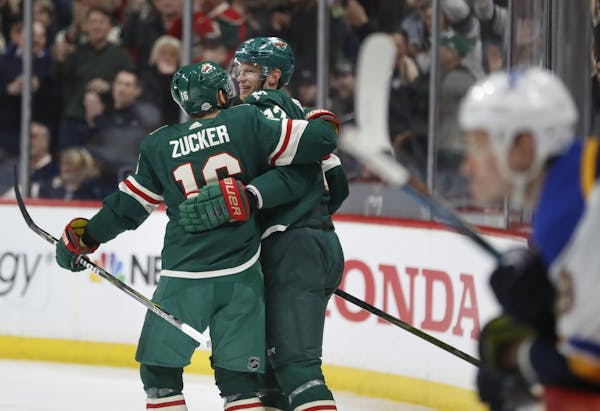Eric Staal winced and didn't want to say that being on a bad team for the final of his 12 years with the Carolina Hurricanes contributed to a steep decline in scoring two seasons ago.
"I hate saying stuff like that," Staal said.
But the Wild center acknowledged that life has been much different for him with the Wild than it was in the 2015-16 season, when he split time with the Hurricanes and Rangers — and scored a measly 13 goals, the second-lowest total of his career. Staal said there were even times he didn't know if he would ever regain his scoring touch.
But has he ever. Staal has 33 goals — tied for fourth most in the NHL, and his highest number since 2010-11 — and he could be in the conversation for the Hart Trophy, thanks in part to a recent tear of seven goals in the four games while playing on a line with Jason Zucker and Mikael Granlund. Three more goals sent hats flying Tuesday night in the 8-3 beatdown of the Blues.
"There's always moments you doubt a little bit," Staal said. "You have those moments, and you stay with it. It's not always perfect through your whole career. It's not always on the up."
Staal has been on the up ever since he signed a three-year, $10.5 million deal with the Wild as a free agent before last season. One statistic in particular, his shooting percentage, has, well, shot up since Staal joined the Wild.
Shooting percentage is the kind of statistic that can vary from season to season for even the best players. The league average tends to hover around 9 percent. Some of the game's top scorers are only above 12 percent for their careers, such as Chicago's Patrick Kane (12.2) and Washington's Alexander Ovechkin (12.4). Pittsburgh's Sidney Crosby is a 14.5 percent career shooter but is at 11.5 percent this season.
Those numbers make what Staal has done in Minnesota noteworthy — his shooting percentage was 13.3 percent last season when he scored 28 goals and is at a career high 18.9 percent this season when just two years ago it was a dreary 6.5. Entering this season, Staal was shooting 10.5 percent for his career.
To Staal, the change of scenery — and roster — made a big difference.
"There's probably a lot of different factors, but the reality of it was this team is an experienced team with some established great players already," Staal said. "I just jumped in to fit with the group that was already here. The last couple years in Carolina we missed the playoffs, we weren't very good. It's just the reality of it."
In other words, he has more room to operate when he isn't the lone scoring threat. The surge in scoring and his shooting percentage is no coincidence, even if his rate this season might be unsustainable over the long haul.
Secret of disguise
Staal's shot has something to do with it — particularly his wrist shot. The NHL tracks how players score goals, whether by slap, wrist or snap shot, or by deflection or tip, and Staal leads the NHL in wrist-shot goals with 24.
"My ability to score comes around the net and then comes from the hash marks down," Staal said. "Most of the time from there you're taking snap shots, wrist shots. For me growing up it was about the release and the quickness of getting the puck to the net, putting it in the right spot."
Goaltender Devan Dubnyk, who has to stare down many Staal shots in practice, said his can be one of the most unpredictable to stop.
"It's hard to explain. [The puck] stays on his blade longer than most shots," Dubnyk said. "So it's hard to not drop, to go down. He doesn't show. There's nothing really that he does that shows where he's going to shoot it. He doesn't open his body. It's almost the same release anytime, anywhere on the ice. It makes it extremely difficult because there's no tell, and it's extremely accurate."
That was on display Tuesday on his second goal. On a breakaway, Staal opted not to deke Blues goaltender Carter Hutton and instead fired a wrist shot from the slot. The shot surprised Hutton and found the back of the net.
Getting ice time
Coach Bruce Boudreau said he has tried to utilize Staal's abilities the best he can — as a top-line center. Boudreau said after the Rangers traded for Staal, he was playing out of position at wing on the third line and wasn't scoring as a result. Of late, he has found combustible chemistry with Granlund and Zucker.
"He's a first-line center," Boudreau said. "That's what I told him before he signed here. That's what he continues to be and he has proved us very correct."
Staal has also proven the Wild prudent two seasons ago when it signed him, and he's hoping his shooting doesn't come down from where it is. He credits his teammates for setting him up to score — and for giving him the confidence that might have been lacking before he arrived in Minnesota.
"There's years and times when you don't have that confidence," he said. "Fortunately for me this year it's one of those years where it feels really good."
Chris Hine is the lead writer for North Score, the Star Tribune's new sports analytics beat. Find his stories at startribune.com/northscore.

